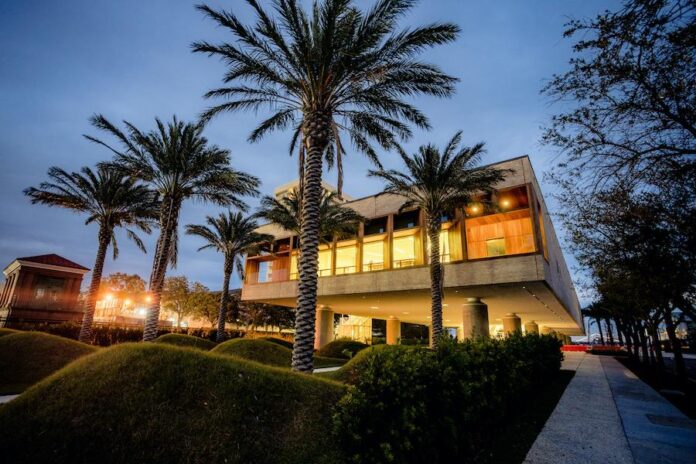After more than two decades of planning, fundraising, and construction efforts, the new International African American Museum (IAAM) in Charleston, South Carolina finally has an opening date: June 27, 2023—just after Juneteenth.
The announcement comes after myriad delays to the project, which was first proposed by Charleston mayor Joe Riley back in 2000. Since then, the size and scope of the prospective museum have changed, so has its location, and securing the $100 million ultimately required to realize the institution proved consistently challenging in the historic southern city still reckoning with its antebellum past.
It wasn’t until late 2019 that work on the museum broke ground. But the pandemic all but halted that less than six months later. The most recent setback came last December, when the museum postponed its planned January opening date because of faulty humidity and temperature controls in its building.
“I now have a really interesting relationship with the word ‘delay,’” said Dr. Tonya Matthews, president and CEO of the museum.
Matthews, who signed as IAAM’s inaugural head in 2021, has come to view the project’s obstacles as mere pit stops on a larger journey. “Every time I’ve looked at what we were discussing, say, five years ago,” she said, “what I realize is that, if the museum had opened at any other time, it really would have been a different space.”
“Ten years ago,” she added, “we weren’t actually going to be located at the site of Gadsden’s Wharf—and that of course has become a signature and grounding point for us.”
Indeed, it’s hard to imagine the museum anywhere else. Located on the Charleston waterfront, Gadsden’s Wharf was once the site of a prolific trading port where hundreds of thousands of slaves first stepped onto American land. It’s a location that shaped American history perhaps as much as Plymouth Rock, but until recently, there were no signs that acknowledged that past.
The IAAM will fix that. In fact, it already has: Designed by architect Henry Cobb, the museum’s building sits atop 18 one-story-tall pillars so as to not touch the ground—a sign of respect for the slaves that once walked the land below. Underneath the building is a tidal pool and an ethnobotanical “African Ancestors Memorial Garden” with indigenous plants from West Africa, the Caribbean, and South Carolina’s Lowcountry. Conceived by landscape designer and MacArthur “genius” grantee Walter Hood, the space is open to the public year-round.

A “Transatlantic Crossings” exhibition at the new International African American Museum in Charleston, South Carolina. Photo: Greg Noire. Courtesy of IAAM.
Inside, the 100,000-square-foot building boasts nine exhibition spaces in which the museum will aim to tell the “full story of the African American journey, from ancient African civilization to modern day.” One room, for instance, will go all the way back to 300 B.C.E to detail the evolution of rice—South Carolina’s cash crop—while another is dedicated to the Gullah Geechee people of the south Atlantic coast.
Some 700 objects belong to the IAAM’s collection—from old slave shackles to ornate Mardi Gras costumes—and just about every one of them will be on view when the institution opens. That includes nearly 80 pieces of contemporary art, which will be displayed throughout the venue in what is being called a “floating” gallery. Among the artists represented in the collection are Nina Chanel Abney, McArthur Binion, Jacob Lawrence, Kara Walker, Carrie Mae Weems, and Hank Willis Thomas.
The mix of art and artifacts speaks to a core theme of the museum, which is, as Matthews put it, “the constant interweaving of trauma and joy.”
“[It’s] not trauma in the exhibit to the left and joy in the exhibit to the right, but much more like the African American experience itself, which is a constant weaving.”
Right now, there are roughly 30 people on staff at IAAM; come June, that number will double. Before the opening, almost all of them will undergo “cultural competency” and “cultural empathy” training—an unusual requirement for museum workers, to be sure.
When asked about the application of those training exercises, Matthews explained that, in the years and months leading up to the museum’s opening, she and her staff have gotten questions that deal with what she calls “high impact, negative emotions”: “’Are you going to yell at people? Are people going to feel mad and sad? Are they going to come out of there angry? Are they going to come out of there feeling guilty?’”
These, the museum head explained, are “questions of fear.”
“That’s where the empathy comes in,” she said. “We are not trying to inflict emotion. We want this to be an emotional place, we want this to be a place where folks can reflect and engage, but… what those emotions are—that’s not up to us. What the museum is supposed to do is to create space for whatever that is. That’s where empathy comes in.”
More Trending Stories:

























